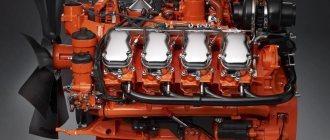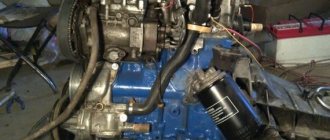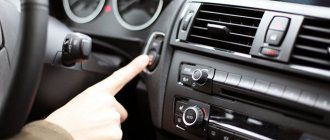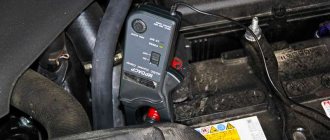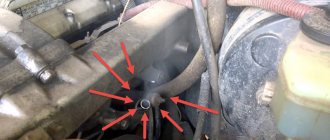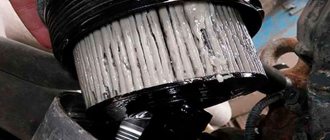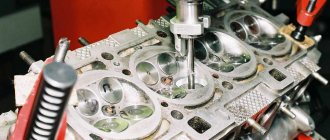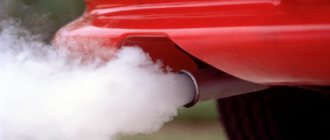There are so many reasons why a diesel engine smokes that it is often impossible to determine the fault without professional equipment. In the article we will reveal the symptoms of the main defects in the operation of injectors, the EGR system, as well as anomalies in the operation of sensors, due to which fuel consumption increases and black/blue smoke is observed after cold start-up and during acceleration.
Diesel smokes when cold
The appearance of gray smoke is a common attribute of cold starts for many owners of cars with a diesel engine. The cause of smoke in cold weather can be one or a combination of the following faults:
- Low compression. The air in the combustion chamber does not heat up enough, which is why the injected portion of fuel does not burn completely. The smokiness of a diesel engine is associated with a high content of unburned fuel vapors in the exhaust gases.
- Malfunction of the preheating system. Glow plugs are necessary not only for preheating the combustion chamber before starting, but also for better combustion of fuel in the first minutes of engine operation. The duration of their activation depends on the algorithm laid down by the designers, which takes into account the load on the engine, the temperature of the coolant, intake air, etc. If one or several glow plugs are faulty, the fuel in the corresponding cylinders will burn incompletely. In this case, not only gray smoke from the exhaust pipe is noticeable, but also uneven engine operation and increased vibration.
- Exhaust gas recirculation (EGR/AGR) system jamming. If the exhaust gas return valve does not close completely, the exhaust flows back into the intake manifold and displaces some of the fresh air charge. At the same time, the temperature in the combustion chamber decreases, resulting in smoke with a gray tint.
- Incorrect operation of fuel injectors. A significant deviation from the reference characteristics leads to an increased cyclic feed. A large portion of fuel does not burn completely, which leads to a high concentration of unburned diesel fuel in the exhaust gases.
- Injection angle too late. In systems with electronic control of the injection angle, a malfunction occurs due to incorrect installation of timing marks or a defect in the operation of the injection timing regulator. On a car with a mechanical injection pump or a high-pressure pump with a relatively simple mechatronic design, the injection angle is affected by the correct position of the injection pump gear relative to the crankshaft and camshaft.
- Defect in the operation of the mass air flow sensor, absolute pressure sensor in the intake manifold. If the sensor readings differ significantly from the actual mass of the fresh air charge, the cyclic supply will be calculated incorrectly, which can lead to overflow and poor combustion of fuel in the cylinders.
How to avoid smoke
There are several recommendations for caring for a diesel engine that will reduce the risk of black exhaust.
How to avoid engine smoke
- Timely replacement of the air filter . It is necessary to monitor the condition of the filter element, clean it if necessary or change it.
- Checking air ducts for leaks . You need to check the intercooler, clamps and hoses. For diagnostics, you can use a regular bicycle pump.
- Diagnostics of injection pump . The high-pressure fuel pump must always be in good condition, therefore, if a breakdown is suspected, bench diagnostics are necessary.
- Monitoring the condition of fuel injectors . It was previously noted that carbon deposits accumulate on their walls, so the injectors must be periodically removed from the block head for visual inspection.
- Checking compression in cylinders . This procedure must be performed periodically. A compression gauge is used for this purpose.
Why do you need a diesel particulate filter?
Modern diesel cars are equipped with a special particulate filter that needs regular cleaning. At the end of its service life, the filter must be changed.
Old school
It is worth making a digression and mentioning “old” school engines, whether swirl chamber or direct injection, on which environmental limiters in the form of a particulate filter, catalyst or USR system are not available from the factory or have been cut out/removed by the owners. If gray smoke with a bluish tint in the first minutes after starting the engine in cold weather does not appear in conjunction with poor starting, loss of dynamics, harsh and uneven operation, the owner should not worry.
Slightly decreased compression, deviations in cyclic flow due to wear of injectors, imperfect operation of individual sensors are a natural consequence of long years of operation and high mileage. The owner just needs to make sure that the thermostat, glow plugs, USR and idle speed increase system are in good condition, which are extremely important for quick engine warm-up and smooth operation after a cold start.
A case from one's life
Mechanics tell one story on this topic. The cylinder head gasket on the unit was replaced. After the engine was assembled, we discovered strong shaking at idle. After a couple of kilometers these vibrations stopped, and after a couple of minutes of idling the shaking reappeared. Mechanics analyzed this situation and found out that the new gasket was slightly thicker. Until the diesel engine warmed up to operating temperature, it did not work smoothly.
So, the main cause of blue smoke is late fuel injection and low compression performance. Many modern engines have a device that performs injection a little earlier. Cars work harder, but the fuel in the cylinders heats up and burns without smoke, that is, at all. Then the unit heats up, the coolant heats up the actuators, and they return the injection advance piston to its rightful place. The motor runs smoother and more pleasant.
Why is black smoke dangerous when accelerating?
Diesel smokes black smoke in the case of an over-enriched mixture, when the air entering the cylinders is not enough for complete combustion of the injected portion of fuel. Often, thick black smoke is observed during sudden throttle changes, intense acceleration, or when driving under load. The main reasons for increased smoke:
- Insufficient air entering the intake manifold. A lack of oxygen can be caused by a clogged air filter, a leak in the intake tract, or a malfunction of the turbocharger.
- Excessive fuel supply. Most often, the cause of overflow lies in faulty injectors, but a similar situation is possible in the event of improper operation of the mass air flow sensor or absolute pressure sensor (DBP). If the sensor readings do not correspond to the actual amount of air entering the intake tract, the ECU (Engine Control Module) is not able to select the correct amount of fuel. The mixture turns out to be over-enriched, which is why black exhaust from the diesel engine is observed.
- Changing the timing and duration of fuel injection. The reason may be either faulty injectors or control. The timing of injection and the duration of the open state of the injectors can be affected by incorrect operation of the sensors that record the load on the engine (mass air flow sensor, DBP, gas pedal position sensor), as well as changes in the ECU firmware. When chip tuning, changes to the fuel map are made intentionally to increase the power of the diesel engine.
- EGR valve stuck in open position. Incomplete blocking of the exhaust gas return channel leads to a decrease in temperature in the combustion chamber. If the EGR valve does not close completely under full load, the air-fuel mixture does not burn completely and black smoke comes out of the pipe.
- Low quality diesel fuel.
- Incorrect installation of timing marks.
A general violation of the cyclic fuel supply or uneven fuel supply between the cylinders leads to increased loads on the parts of the cylinder-piston group, the crankshaft and its liners. Significant overflow can destroy the piston partitions and cause scuffing on the liners, which will subsequently lead to them turning over.
Where is the smoke coming from?
What are exhaust gases? This is a product of combustion of the fuel mixture in the combustion chamber of a car. But if for gasoline engines the presence of smoke even at minimum speed is considered the norm, then a diesel engine, in turn, should not smoke. Smoke may appear only when the load on the power unit increases.
The combustion process of diesel fuel in an internal combustion engine
Note! You can often see a truck moving uphill leaving behind a black cloud of exhaust fumes. But as soon as he drives out onto a flat road and the load is removed from the engine, the soot immediately disappears.
Why does diesel smoke
When conducting diagnostics, auto mechanics first of all pay attention to the color of the smoke, since it is often associated with certain malfunctions. Typically, exhaust gases can be white, black or even blue.
Diesel smoking under increased load
What does the white and bluish color of exhaust gases mean?
If a diesel engine emits blue smoke, the engine oil burns in the cylinders along with the fuel. Reasons for oil getting into the combustion chamber:
- turbocharger malfunction. Oil enters the intake tract through the turbine shaft seal;
In rare cases, blue smoke is associated with oil burning out of the exhaust pipe, where it enters through the turbine shaft seal in its “hot” part.
- wear of oil scraper rings. Piston rings are necessary to remove excess oil film from the cylinder walls. If the rings do not cope with their task, the oil remaining on the walls burns along with the air-fuel mixture;
- wear of valve seals. Seals are designed to seal the cylinder head cavity from the combustion chamber. Over time, due to frequent temperature changes, the rubber seals harden and begin to leak oil into the combustion chamber. Most often, in this case, smoke with a bluish tint appears after the car is idle and disappears a few minutes after starting the engine;
- increased pressure of crankcase gases. The reason is either wear of the cylinder-piston group, or improper operation of the crankcase ventilation system. Excessive pressure in the crankcase space prevents the normal operation of the oil scraper rings and the drainage of oil from the turbine.
Diesel smokes white smoke when it burns antifreeze in the cylinders. Ways it enters the combustion chamber:
- contact area between the cylinder head and the cylinder block. The reason may be corrosion of the cylinder head or a loose gasket. Antifreeze getting into the cylinders can be caused by deformation of the cylinder head/cylinder head mating planes (often due to engine overheating), installation of a poor-quality gasket, or non-compliance with the cylinder head installation rules;
- Cracked cylinder head or cylinder liner.
Video: The reason why diesel smokes when cold, which many people don’t know about, Ford Connect 1.8d, HCPA
All shades of blue
The causes of blue exhaust are varied. These include disturbances in the formation of the fuel torch, poor conditions for its self-ignition, and, finally, oil getting into the working chamber. Each factor has its own shade of smokiness.
Blue exhaust with a pungent, pungent odor indicates insufficient efficiency of the fuel jet. Some of the fuel does not burn, but flies out of the muffler in the form of tiny droplets, which give the exhaust a blue color. But this is not so bad, because combustion of the main mixture does not occur in the air volume of the compression chamber, but quite often at the bottom of the piston. It is not worth reminding that this will lead in the near future to its burning, scuffing on the surface of the cylinders and to very expensive repairs.
The bluish tint of the exhaust gases indicates difficulty in self-ignition of the fuel mixture. Firstly, insufficient pressure (compression) at the end of the compression stroke. The main reason is the wear of the CPG parts. Low compression is also caused by loose fit of the valve plates to the seats as a result of the formation of carbon deposits on them. Secondly, the temperature is insufficient for self-ignition due to a malfunction of the glow plugs.
Finally, smoke of different shades, ranging from light blue to deep blue, indicates that oil is burning in the cylinders. Where does it come from:
- from the engine crankcase through the oil scraper rings, if they are worn out or stuck in the grooves;
- from the valve box through worn valve stem seals;
- through compressor turbine bearing seals;
- from the air filter when the crankcase ventilation is clogged.
Anti-smoke additives - a panacea or a waste?
Various auto chemical brands offer special additives to reduce oil consumption. They form a film on the rubbing parts of the engine that protects them from wear and fills existing microcracks. The use of additives replaces the decoking of piston rings, cleaning them from dirt. Manufacturers promise all this, but is it really so?
On auto forums you can find conflicting opinions about anti-smoke additives. Some auto mechanics note that the use of such products makes it difficult to overhaul the engine. The engine parts are covered with an oil layer, which is very difficult to completely wash off. Individual parts that could simply be cleaned have to be replaced, which means repairs are more expensive.
The additive only slightly extends the life of the engine before repair, but does not guarantee its trouble-free operation.
Other causes of smoke in diesel engines
- Malfunction of the CCVV (crankcase ventilation valve). This problem is typical for BMW cars. When accelerating hard, the diesel produces thick white smoke. Replacing the valve solves the problem.
- Engine oil overheating. The problem manifests itself under extreme loads on the engine (full weight load, prolonged ascent) - then thick white smoke pours out of the muffler. The solution is to replace the oil with a higher quality one and not subject the engine to overload.
- Worn or hardened valve seals. The problem is typical for domestic cars with a diesel engine. It manifests itself as an abundant emission of white-blue smoke in the first seconds after starting the engine. As it warms up, the smoke goes away. The solution is to replace the valve stem seals.
Common causes of smoke
As you know, the fuel-air mixture burns in the engine cylinders. The fuel enters here through the injector nozzles and “meets” the air, which is supplied through the intake manifold. The cylinder pistons create the pressure necessary to mix air with fuel. When the entire system works like a clock, the mixture burns almost completely, and the emission of hydrocarbons into the atmosphere is minimal. The smoke that comes out of the exhaust pipe when the engine starts is the result of incomplete combustion of the fuel mixture for various reasons:
- The injection advance angle is off.
- Uneven fuel spray.
- Insufficient air supply to the cylinder block.
- Fuel is of low quality, with a high concentration of sulfur.
Let us immediately note that it is impossible to find out the exact cause of the breakdown only by the type of exhaust. The color of the smoke will tell you where to look for a problem (cooling system, compressor, etc.), which will save time. But an accurate “diagnosis” will only be made by a complete diagnosis of all systems, which is best not to delay.
Elementary Watson
Ideally, the exhaust of a working diesel engine should be transparent. If a diesel engine smokes, this indicates a malfunction or malfunction of one or more engine systems. Moreover, the culprit of the increased smokiness is revealed by the color of the smoke. Looking ahead, we can say:
- gray or black smoke indicates incomplete combustion of fuel;
- bluish-blue or gray color of the exhaust indicates loss of lubricating oil and some other reasons;
- fluffy white clouds, reminiscent of a bubbler blowing out (as hookah lovers say), are actually coolant entering the combustion chambers.
So a preliminary diagnosis is determined by the color of the exhaust. A more accurate determination of the cause of smoke will be determined by specialists at a service station (STS), using diagnostic equipment and a gas analyzer. The table shows some figures regulating the maximum content of harmful substances emitted into the atmosphere. Possible malfunctions in engine systems are also indicated.
| Chemical element | Standard for diesel engine | Reason for non-compliance |
| Nitrogen (N2) | 76 — 78% | Lean fuel mixture, engine overheating |
| Oxygen (O2) | 0.5% max. | Exhaust manifold leaking |
| Carbon monoxide (CO) | 0,01 — 0,5% | Clogged filters, high fuel pressure in the power system, over-rich mixture |
| Carbon dioxide (CO2) | 1,0 — 10% | Clogged filters, excessive fuel pressure, over-rich mixture |
| Hydrocarbons (CH) | 50 PPM max. | Misfire (faulty glow plugs), rich mixture |


